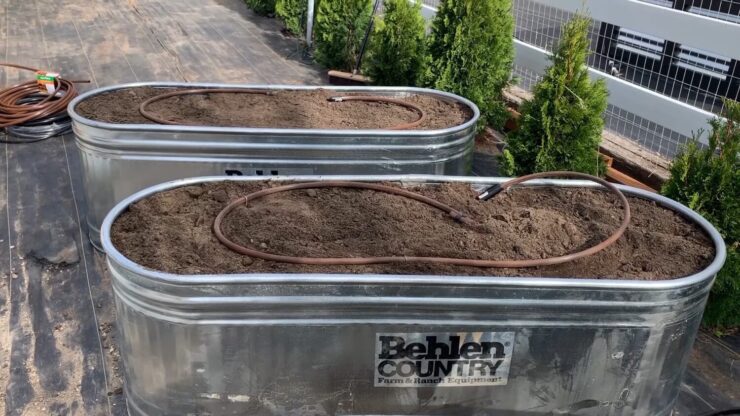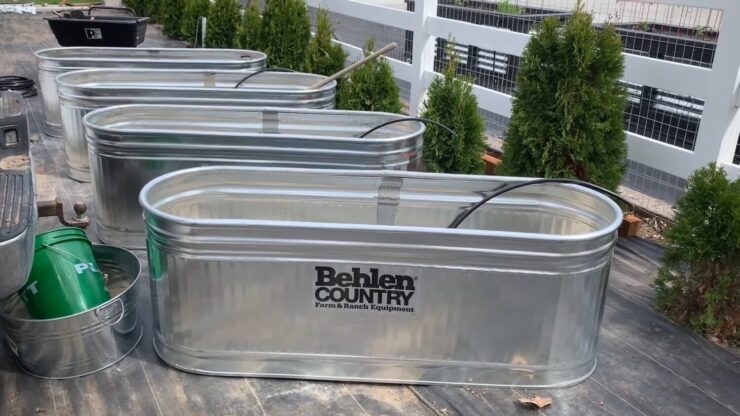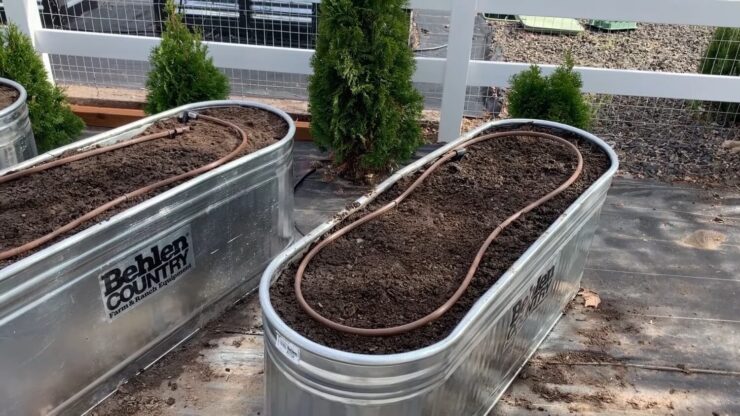Of all the things in our landscape, I think the galvanized cattle troughs (also known as stock tanks) in our backyard get the most attention. Even in the winter when nothing is growing in them, their shapes and sheer size turn heads and provoke questions. We added them to what we’re now calling “our little farm” a couple of years back when we lost a huge oak, and I figured I’d take advantage of the sun to grow some vegetables. After starting with one trough, we added another last year and we’ll be getting one more in the next few weeks.
If you want to grow some food on a small, urban lot, you can’t beat these troughs for being easy to get going. You don’t have to build anything, and you don’t have to deal with turning depleted urban soil into something safe, nutrient-rich and workable enough to grow food in. They’re also affordable, durable and tall enough to be out of the way of hungry critters and peeing dogs.
People ask all the time where we got the troughs and how to turn one into a raised bed garden, so even though I wrote briefly about this a couple of years ago, I thought I’d explain the process more in-depth here since it’s the perfect time to get raised beds going for the season. Let’s start with where to buy them. Unless you are literally made of money, do not go to a boutique garden center for a livestock trough. You want to go where farmers buy stuff — Tractor Supply Co. and Fleet Farm.
If you want to grow things like tomatoes, peppers, beans and squash, get yourself a large trough. One of ours is four feet long and the other is six feet. Both are 2 feet wide and 2 feet deep, and they cost about $80 and $110, respectively. Aside from getting the things home in the back of the car, the biggest job is drilling holes in the bottom for drainage.
Use a bit that can drill through metal that’s about the size of a dime of nickel. We drilled holes every few inches all around the outside edge along the bottom, and then added many more holes going across the bottom of the trough from end to end and side to side. Remove the drain plug, too, since you won’t be needing it.
Once you’ve got your holes drilled, flip the trough over and put it wherever you want it because once you fill it with soil, you won’t be able to move it around without taking most of that soil back out. We don’t like things looking all kittywampus so we used a level to make sure the trough was lined up properly once we got it situated. (You don’t have to do that unless you’re bugged by such things.) Now comes the soil part. My advice — don’t cut corners. Good soil makes all the difference when you’re growing anything.
Because these are containers, albeit huge ones, you want a mix that’s going to drain well. You also want to provide plants with some nutrients that you’ll boost over time by adding compost and fertilizer. You’ll save some money if you make your own mix by combining 1 part topsoil, 1 part compost and 1 part coconut coir or coarse sand (also known as builder’s sand).
I’ve done this by combining these things in batches in a wheelbarrow and it worked well. But I’ll admit, it’s a heck of a lot less work to call someone and have a quality potting mix delivered to your driveway. That way, you can just shovel it into a wheelbarrow and take it right over to your trough and other containers.
What do I mean by a quality mix? As I’ve said in the past, I’ve learned a lot about soil and compost over the last few years and I’m now opting to go with products that are organic or at least produced by a company or farmer who is willing to explain their process so I can make an informed decision about whether to use it.
Local organic growers give products from Purple Cow Organics, COWSMO and Mississippi Topsoil high marks. Other local sources that come highly recommended are Kern Landscape Resources and Kelley and Kelley Nursery. Compost from Linden Hills organics recycling program is also pretty good. But because it includes packaging, paper and other odd bits, I don’t use it to grow edibles. That’s just me.
Keep in mind that even though it’s costly to fill your trough with quality potting mix the first year, in subsequent years (unless you get some dreaded disease like early blight of tomatoes) you’ll only need to add a bit more compost to keep soil healthy. If you feel like you’re having drainage issues, add more coir or sand. With the hard part behind you — all you have to do is keep growing.
You can try mixing your rock garden up with these cattle troughs as they can add that little something to your outdoor space.
Get Those Seeds Going
Even though it snowed yesterday — again — I have hope that spring will have actually arrived for real by the time this column runs. So, with that hope in my heart, let me once again invite you to visit the Little Free Seed Bank at my house.
As some of you probably know since I keep yapping about it, my husband Mike and I put up one of those Little Free Library boxes last year and I’ve designated the top shelf as a space for sharing seeds. You’ll find our brightly painted box on the boulevard at the Northeast corner of Washburn Ave. and 45th Street in Minneapolis.
Lots of people have been stopping by to take and drop off seeds over the last month. If you want to help monarch butterflies, come by and grab yourself some red swamp milkweed seeds. There’s plenty to go around, and I’ve got more in the house so I keep restocking the supply.
Unlike common milkweed, red swamp milkweed (Asclepias incarnata) is a well-behaved native that’s not invasive. Clusters of pretty pink blooms open in June and last for a couple of months if you snip off spent blooms. Plant your seeds in full sun (a little shade is okay) and water fairly regularly because red swamp milkweed prefers moist soil but can tolerate periods of dryness.
Red swamp milkweed isn’t the only butterfly-friendly plant in the box. You’ll also find the queen of the prairie (Filipendula rubra) and queen Anne’s lace (Daucus carota). Also known as meadowsweet, queen of the prairie has become one of my favorite garden plants. It looks similar to red swamp milkweed but the pink flowers are showier and a little bit fluffy looking. They like moist soil and will spread some, but not to the point of being annoying.
Queen Anne’s lace is a lovely plant with white, lacy blooms that last from June until September or even October. Because it’s a biennial, it blooms the second year after planting, so just be aware of that if you want to grow this. Eastern black swallowtail caterpillars love to eat the leaves of Queen Anne’s lace and bees and other pollinators drink the nectar.
The only problem with this plant is that it will take over your garden like nothing you’ve ever seen if you let the seed heads dry out and blow all over the place in the fall. Hear me now, gardening friends, don’t do that or you will be terribly, terribly sorry. I’ve done it, over and over again, actually.
Watch this video for more information on how to turn the stock tanks into raised beds:
So don’t make my mistake and sit around looking at the pretty seed heads drying out in the fall — get your pruners and CUT THOSE HEADS RIGHT OFF. Do that and you can grow this awesome plant without worry and the butterflies and bees will thank you.
Of all of the seeds currently out there, the highlight to my mind, is Lauren’s Dark Grape, an heirloom poppy with deep-purple blooms that are so gorgeous, they seem otherworldly. I have a few seeds left that were donated by my new friend, Melissa, who has grown these beautiful poppies in her own gardens for years.
Thanks, Melissa! Because the seeds are so tiny, I’ve noticed that it’s not very easy to transfer them into envelopes to take home, so I’ve brought the seeds inside for safekeeping.
Now is the time to sow Lauren’s Grape seeds. They do best when they start out in cool spring weather. If you miss the spring window of time, don’t worry. You can sow seeds in late summer for spring bloom next year. Be sure to sow seeds directly in the garden because they don’t transplant well.
And don’t really cover them with soil; just rake them in very lightly. Because they’re teeny little poppy seeds, it will be easier to sow them if you mix them with a little bit of sand. Once you get these poppies going, they should self-seed from year to year. Happy spring!















